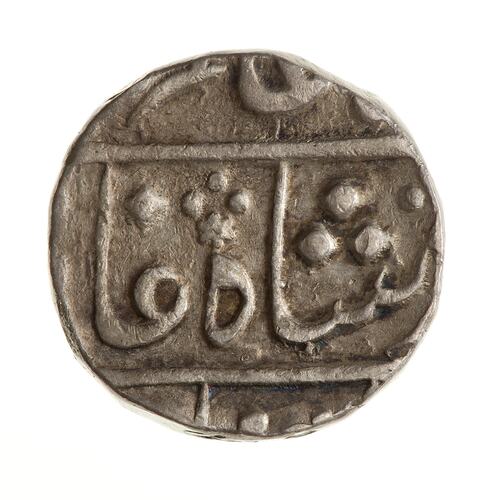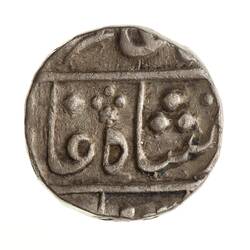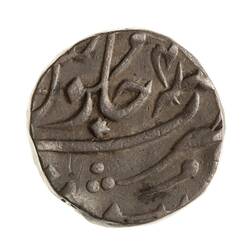Summary
1 Rupee, Issued by Bombay Presidency, India, 1800 - 1824
Surat 46 San in the name of Shah Alam
Minted by Bombay Mint (with mint name Surat but Bombay privy mark Pridmore type 6)
Note: In this issue the dies were larger than the coin flans with the result that only part of the obverse and reverse legends are found on any coin
Obverse Description
Legend in Persian script, much off flan (full legend translation: The auspicious coin of the Victorious Emperor Shah Alam)
Reverse Description
Julus formula legend in Persian script, much off flan (full legend translation: Struck at Surat in the 46th year of his reign of tranquil prosperity) - with star instead of the usual diamond shaped mark near the centre of the flan
Edge Description
Plain
Significance
A debasement of the silver alloy at the Surat mint in about 1788 saw the mint at Bombay produce no silver for about ten years. Then in 1800 a group of merchants requested a coinage of rupees at Bombay to save time and reduce risk. It was decided to fulfill this request with Bombay producing coins almost identicle to those from Surat (including the mint name Surat though this was in most cases off the flan) but with small identification marks, in this case a star replacing the fourth dot of decoration after the word Shah. On 27 January 1801 regulations were put in place for the Bombay mint which abandoned the old Bombay rupee standard in favour of the Surat standard. Rupees of this type were struck at Bombay until 1825 (the Surat mint was closed in 1815 but its name retained at Bombay)
More Information
-
Collecting Areas
-
Date Issued
1800-1824 AD
-
Issued By
-
Mint
-
Denomination
-
Series
-
Material
Silver
-
Axis
05
-
Classification
-
Category
-
Discipline
-
Type of item
-
Dimensions
19 mm (Outside Diameter), 11.49 g (Weight)
-
Shape
Round
-
References
Pridmore 270 KM#211.2
[Book] Pridmore, Fred. 1975. The Coins of the British Commonwealth of Nations, Part 4, India. 1.
[Book] Bruce, Colin R. 2006. Standard Catalogue of World Coins 1801 - 1900., 695 Pages
-
Keywords
British Commonwealth Coins, British Commonwealth and Empire Coins



